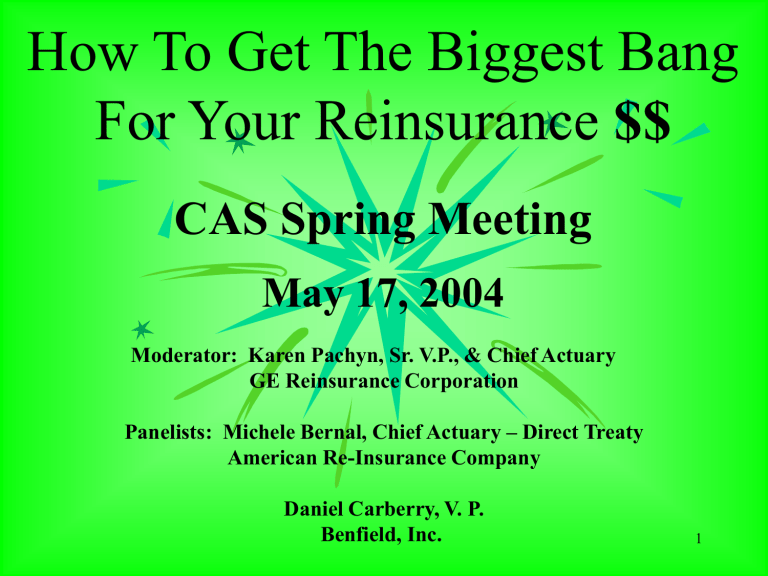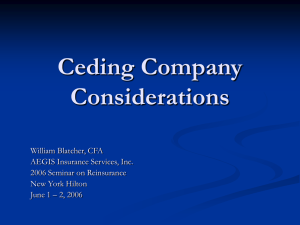How To Get The Biggest Bang $$ CAS Spring Meeting May 17, 2004

How To Get The Biggest Bang
For Your Reinsurance
$$
CAS Spring Meeting
May 17, 2004
Moderator: Karen Pachyn, Sr. V.P., & Chief Actuary
GE Reinsurance Corporation
Panelists: Michele Bernal, Chief Actuary – Direct Treaty
American Re-Insurance Company
Daniel Carberry, V. P.
Benfield, Inc.
1
How to Get the Biggest Bang for Your Reinsurance Buck
• Make Sure Your Reinsurer Understands What’s Happening
With Your Business
•
Give Him/Her Data to Demonstrate It
2
Discussion Topics
• General Issues Given Where We Are in the Market
•
Importance of Price Monitoring
•
Loss Development Issues
• Line of Business Issues
Umbrella
Work Comp
Contractors/Construction Defect
Property
•
Special Issues Surrounding Cat and Terrorism Exposures
3
General Issues
• Reinsurers Use Two Basic Pricing Approaches
Experience Rating
Exposure Rating
•
Also Want to Know Current/Projected Rates
4
General Issues
• Reinsurers Rely Heavily on Historical Data
How Does This Compare to Your Going Forward Book
In Hard Market, Favorable Changes Made
May Not Be Evident in Standard Data Request
Help Reinsurer Understand These Changes
What Were They
How Will They Impact Your Loss Ratio
What Data Can You Provide to Support That
5
General Issues
• Common Changes in Hard Market
We No Longer Write in State X
Provide Data by State
We Cancelled a Bunch of Agents
Provide Data for Those Agents Vs. Others
Explain Why Business Won’t Just Go to Agent Across the Street
We Got Out of Classes of Business
Provide Data With and Without Those Classes
Why Those Classes?
Prove It Wasn’t Just Bad Luck That Caused the Classes to Be Bad
We’ve Changed Our Underwriting Standards
What Changes Were Made
What Percent of the Business Do They Impact
Why and How Will That Improve the Loss Ratio
6
General Issues
•
How to Get the Reinsurer to REALLY Buy Into What You Are
Telling Them
Give Them a History of at Least 5 to 6 Years, Not Just Last Year
Vs. This Year
Provide Premium PLUS Loss Data
Have Direct Actuarial Discussions
Make Sure the Data Ties to Other Exhibits/Balances/Makes Sense
7
Importance of Price Monitoring
8
Importance of Price Monitoring
• Cleanest Is Filed Manual Rates in One Company
Ideally Filed Rate Changes
Changes in Loss Costs, Loss Cost Multipliers
Deviations off Rates?
Inflation Sensitive Exposure Base?
Changes in TIV?
9
Importance of Price Monitoring
• Complications
A-Rated Business
Non Admitted Carrier
Tiered Rate Levels – Multiple Companies
10
Importance of Price Monitoring
• A Good Price Monitoring System:
Measures Premiums Charged Year Over Year
Adjusts for Changes in Number of Exposure Units
-
Adjusts for Changes in Limits, Deductibles, SIR’s, Etc.
Adjusts for Changes in Coverage
Captures a Significant Portion of Renewals
Measures New
11
Importance of Price Monitoring
• Price Monitoring Example:
Renewing Prem. Expiring Prem. Price Change
All Policies $ 30,450,000 $ 24,975,000 22%
Policies w/ Eq. Terms 21,125,000 18,500,000 14%
Exposure Base 20,950,000 23,145,000
Price Per Exposure 1.453 1.079 35%
12
Importance of Price Monitoring
• Price Monitoring
Best Approach – Rerate This Year’s Policy at Last Year’s Rates
Captures Changes in Limits, Exposures, Etc.
Way to Measure New Business
Time Consuming – Automated
If Debits or Credits Judgmental, How Do You Accurately
Capture That?
13
Loss Development Issues
• Reserving Cycle
• Nature of Large Losses
14
Loss Development Issues - Reserving Cycle
• Increases in Incurred Loss Development
• Big Question : What Will Development Be in the Future?
• Three Possibilities:
Higher? – Maybe the Higher Development Is Due to Increased Inflation – Case Reserves Are Just
Barely Keeping Up, and Incurreds Will Increase
More in the Future
Lower?
– Our Reserves Are Much Stronger Than
They’ve Been in the Past, So Future Development
Will Be Less
Somewhere in Between? – If So, Where?
15
Loss Development Issues - Reserving Cycle
How Do You Know?
What Can You Do?
What Will Your Reinsurer Do??
16
Loss Development Issues – Reserving Cycle
• How Strong Are the Reserves?
- Provide Triangles of Paid/incurred Ratios
- If Reserves Are Stronger Than Historical, Ldf’s Can
Be Adjusted Downward
•
Are Losses Being Distorted by Timings of Claims
Closings or an Increase in Settlements?
- Provide Triangles of Closed Claims and Reported
Claims to See % of Claims Remaining to Be Closed
- If More Claims Closed Than Historical, Tail Can Be
Reduced
•
Is It Inflation or Just Reserve Strengthening?
- Provide Paid or Closed Losses/closed Claims
17
What About Large Claims?
18
Loss Development Issues – Large Claims
• Important to Understand Differences Between How
Small and Large Claims Are Reserved
Different Department?
Are Initiatives That Impact Aggregate Losses
Impacting the Large Losses in the Same Manner?
19
Loss Development Issues – Large Claims
• Leveraged Impact of Development on Excess Losses - WC
Primary vs Reinsurer
(Source: RAA / AM Best)
100%
80%
60%
40%
20%
0%
1 2 3 4 5 6 7 8 9 10
Report Period (Years)
Primary Reinsurer
20
Loss Development – Large Claims
Variations in Excess Development
Work Comp – 500k X 500k
6.00
5.50
5.00
4.50
4.00
3.50
3.00
2.50
2.00
1.50
1.00
36 48 60 72
Months of Development
84
--- Harmonic Mean --- 75th %ile
96
21
Loss Development Issues – Large Claims
What Can I Do?
•
Important to Track Large Claim Data at Historical
Valuations
E.G., Each Year-end Since Reported.
• Reinsurer Can Build Loss Development Triangles for On-level Excess Losses
22
Line of Business Issues
23
Line of Business Issues - Excess and Umbrella
• Historical Experience
Loss Listing
Umbrella Limits Associated With Loss
Underlying Limits
Line of Business
Underlying Carrier
Signal Reserves Vs. Other
Most Recent Evaluation As Well As Prior Evaluations
24
Line of Business Issues - Excess and Umbrella
• Historical Experience
Premium Trends – Want to Get Full Credit for Big Increases!
From Price Monitoring
Support for Trends
Minimum Premiums – When and How Much
Auto Unit Rate Changes
Factors for First Million As % of U/L
Factors for Subsequent Millions
Credits or Debits Allowed
Handling of Underlying Rates
Trends in Underlying Rate Levels
Average Premiums Per Million Changes
Admitted Vs. Non Admitted
Current and Future Rate Levels & Strategies for Achieving
25
Line of Business Issues - Excess and Umbrella
• Historical Experience
What Else Is Different Today Vs. Yesterday
Attachment and Limits Point Profiles – Current and Historical
Mix of Supported Vs. Unsupported
Type of Risks in Portfolio
26
Line of Business Issues - Excess and Umbrella
• More on Limits Profiles
Matrix Format
Attachment Point 1000 2000 3000 4000 5000 10000 Total
300 5% 5%
500 8% 12% 20%
1000 43% 15% 7% 5% 3% 2% 75%
Total 56% 27% 7% 5% 3% 2% 100%
27
Line of Business Issues - Excess and Umbrella
• More on Limits Profiles
Individual Policy Listing
Insured U/L Carrier U/L Limits X/S Limits CC’s Share LOB
Krispy Crunchies Feelings Mut. 5000 25000 10% Auto
Colorado Dreams ABC Ins. Co. 1000/2000 5000 100% Prod.
• • • • • • •
•
•
•
• • • • • •
• • • • • •
• • • • • •
28
Line of Business Issues – Workers Comp
• Are Claims “Discounted”?
They All Are
Medical Inflation Is Not Contemplated
Mortality Tables in Stat Plan Have State-specific
Discount
Discount for Reduced Life Expectancy
Most Claims People Aren’t Aware of This
“Discount”
The Difference in Reserve Levels Is the Degree of
“Discount”.
29
Line of Business Issues – Workers Comp
• Impact of Settlements
- Some States More Accommodating
- Some Companies More Aggressive
- Paid Development Up
- Incurred Development Down
• Provide # of Settlements and Size by Year
- Reinsurer Can Adjust Tail Downward
30
Line of Business Issues – Workers Comp
• Benefit Changes Impact Different Claims Differently
California
AB749 – Significant Increases in Permanent Total
Benefit Levels
SB899 – Significant Savings in Aggregate Losses and Average Medical Losses; Impact on Severe
Claims Uncertain
Net Effect on XS Loss Rates?
• Separation of Data Between Medical, Indemnity and
ALAE Can Improve Accuracy of Projections on a 1 st
Dollar Basis.
31
Line of Business Issues – Workers Comp
• Premium Issues
- Treatment of Retro Premiums
Prior Year AP’s Usually Included in Current Year EP
Provide Estimate of Historical & Prospective
Adjustments, or
Use Standard Premium As a Subject Base?
Make Sure Contract Wording Is Clear
- Treatment of Audit Premiums
- Treatment of Dividends
32
Line of Business Issues – Contractors
• Important to Track Historical Timing of
Changes in Forms
• Helpful If Claims Not Covered Under New
Forms Could Be Identified
33
Line of Business Issues - Property
• Special Considerations for Excess Per Risk Covers
Exposure Rating
PSOLD Expects Limits to Be Building and Contents Only
Limits Should Be on a Per Location Basis
Excess??
34
Data And Property Catastrophe
Reinsurance Pricing
35
Data And Reinsurance Pricing
Agenda
•
Catastrophe Reinsurance Pricing Overview
• Loss Variability
• Terrorism Coverage Considerations
•
Conclusions
36
Catastrophe Reinsurance
Pricing Overview
37
Catastrophe Reinsurance Pricing
Basic Pricing
•
Premium = Modeled Pure Premium To Layer +
Factor Of Standard Deviation
• Capital Allocation, Return On Equity At PML Level
•
Dependent On Modeling
38
Catastrophe Reinsurance Pricing
Other Considerations
•
Existing Capacity By Region
• Loss Experience
• Lead Markets
•
Prevailing Rate On Line For Business Segment
• Quality Of Data Available
Reinsurer Will Make Conservative Assumptions
39
Catastrophe Reinsurance Pricing
Data Typically Provided To Reinsurers
•
Model Inputs And Outputs
• UNICEDE Data
• Modeling Summary
Explanation Of Changes From Previous Year
Narrative On Expected Changes Going Forward
• Catastrophe Loss Experience
40
Loss Variability
41
Loss Variability
Catastrophe Models
•
Three Widely Accepted Models Used In The
Insurance Industry
• All Produce Different Results
•
Models Change
• Reinsurers Are Using All Of Them
•
Catastrophe Models Are Not Good At Checking
Validity of Data
42
Loss Variability
Data Quality
•
Aggregate Vs. Policy Level
• Street Address Vs. Zip Code
Personal: 90%+ Street Address
Commercial: 50-75% Street Address
Automobile: Almost Always ZIP Code Aggregate
• Use Of Unknowns
Construction, Occupancy, Year Built, Number Of Stories
43
Loss Variability
Data Quality
•
Application Of Deductibles
• Insurance To Value And Guaranteed Replacement Cost
•
Data As Of Date
44
Loss Variability
Data Quality
•
All Data Captured?
• Inclusion Of Facultative Or Surplus Share Data
•
Bulk Coding Of Commercial Locations
• Number Of Buildings
•
Scheduled Property (Inland Marine)
45
Loss Variability
Other Factors
•
Demand Surge
• Storm Surge
•
Allocated Loss Adjustment Expenses
• Law/Ordinance Coverage
•
Inuring Reinsurance
46
Terrorism Considerations
47
Terrorism Considerations
Data Available
•
Property Data – Usually Available From Catastrophe
Modeling Exercise
• Worker’s Compensation Data – Harder To Collect
At Useful Level Of Detail
• Object Is To Evaluate Exposure To Clash Loss
48
Terrorism Considerations
Tools Available
•
Accumulation/Concentration Analyses
• Probabilistic Models
•
Deterministic Models
49
CONCLUSIONS
50
Conclusions
Technical Considerations
•
Data Quality And Models Used Affect Catastrophe
Loss Estimates
• Catastrophe Loss Estimates Are The Foundation Of
Reinsurance Pricing
51
Conclusions
Non-technical Considerations
•
Prevailing Market Conditions Matter
• Quality Of Data Affects Confidence
Quality of Data Can Differentiate You In The Market
Reinsurers Will Deploy Capacity Where They Are Most
Comfortable
Good Data Demonstrates You Know Your Exposure
52
Conclusions
What Should You Do?
•
Review Data Capture Regularly
• Make Front End Systems Easy For User
•
Data Programmer Should Understand Exposure
• Involve Catastrophe Modeler In The Data Process
•
Maintain Controls Across The Process
Control Totals
Modeling Assumptions
53
Conclusions
What Should You Do?
•
Provide Data For Revised Underwriting Guidelines
Deductibles
Geographic Restrictions And/Or Growth
•
Run Multiple Models Periodically
• Consider Mid-Year Reinsurance Rate Adjustment
•
Eliminate As Many Questions As Possible
54




